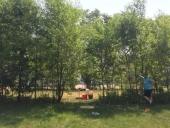posted 12 years ago
Just eating them straight off the tree? I was peeling the skin off the dry ones that were falling off the American elm in my front yard, and ate a few. I remember experiencing some minor throat irritation though it could have been unrelated or just in my head.
The seed seems promising as a staple if it could be collected efficiently. Perhaps by coppicing, or maybe spreading some kind of sheet to catch them.
I was inspired to ask about elms by the thread about Box Elders. Box elder and Siberian elm are the two most common 'weed trees' that grow around here, and after realizing the utility of the Box Elder, I was curious about the Siberian elm.
On a side note, has anyone else noticed the high incidence of bacterial infection on pruning wounds on elms? Almost every cut made results in soft, orange bark below the cut extending down quite some distance. I don't know what this says about the tree, but it could be a clue to something.







